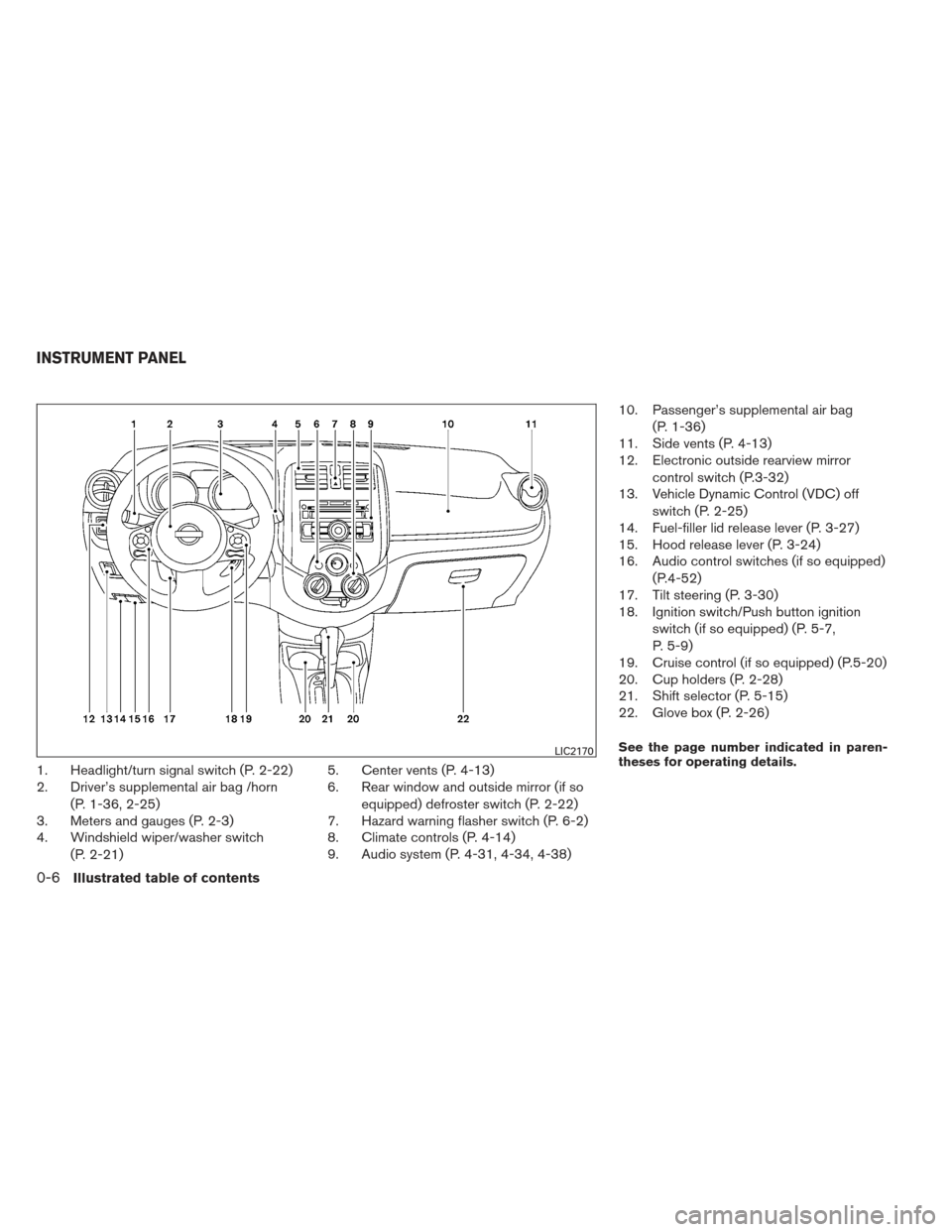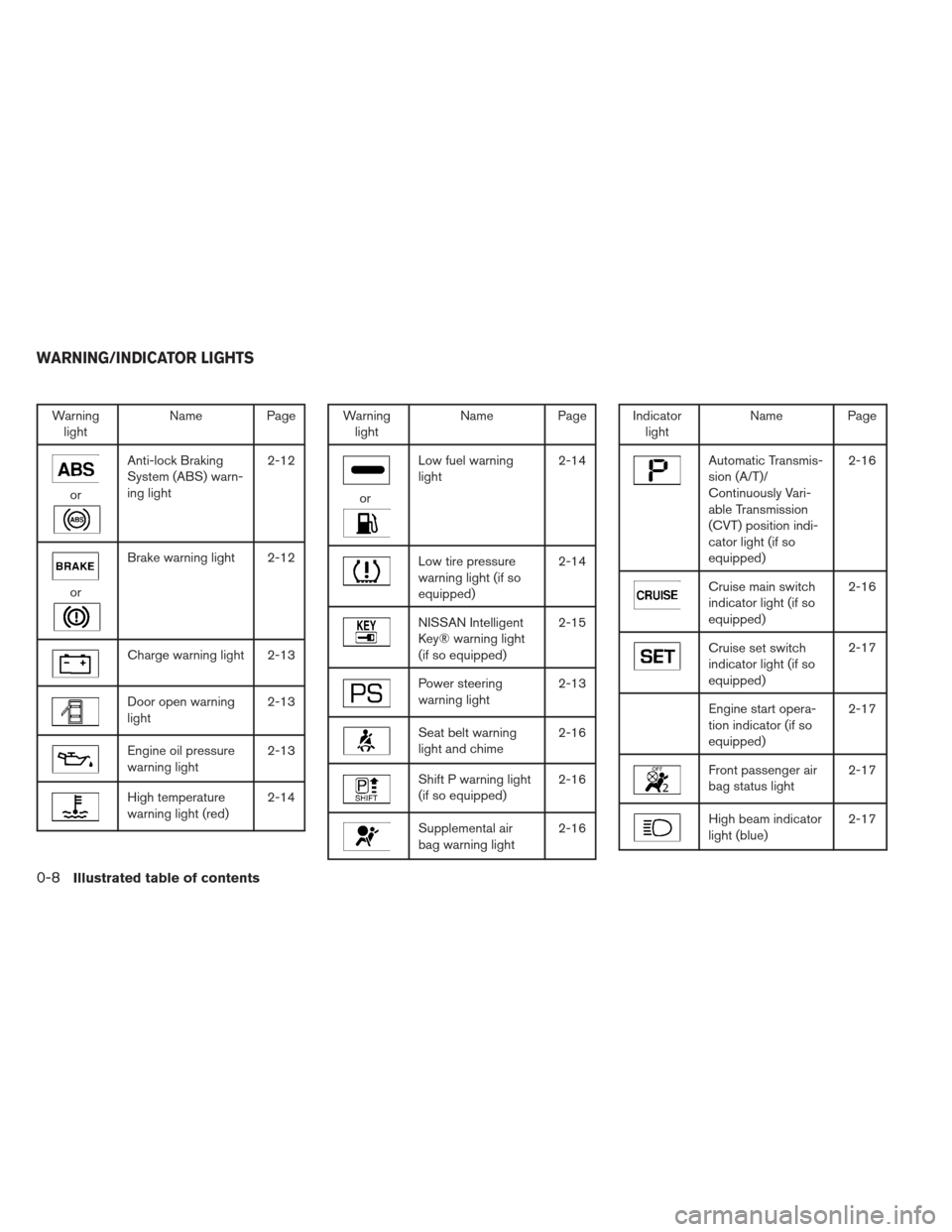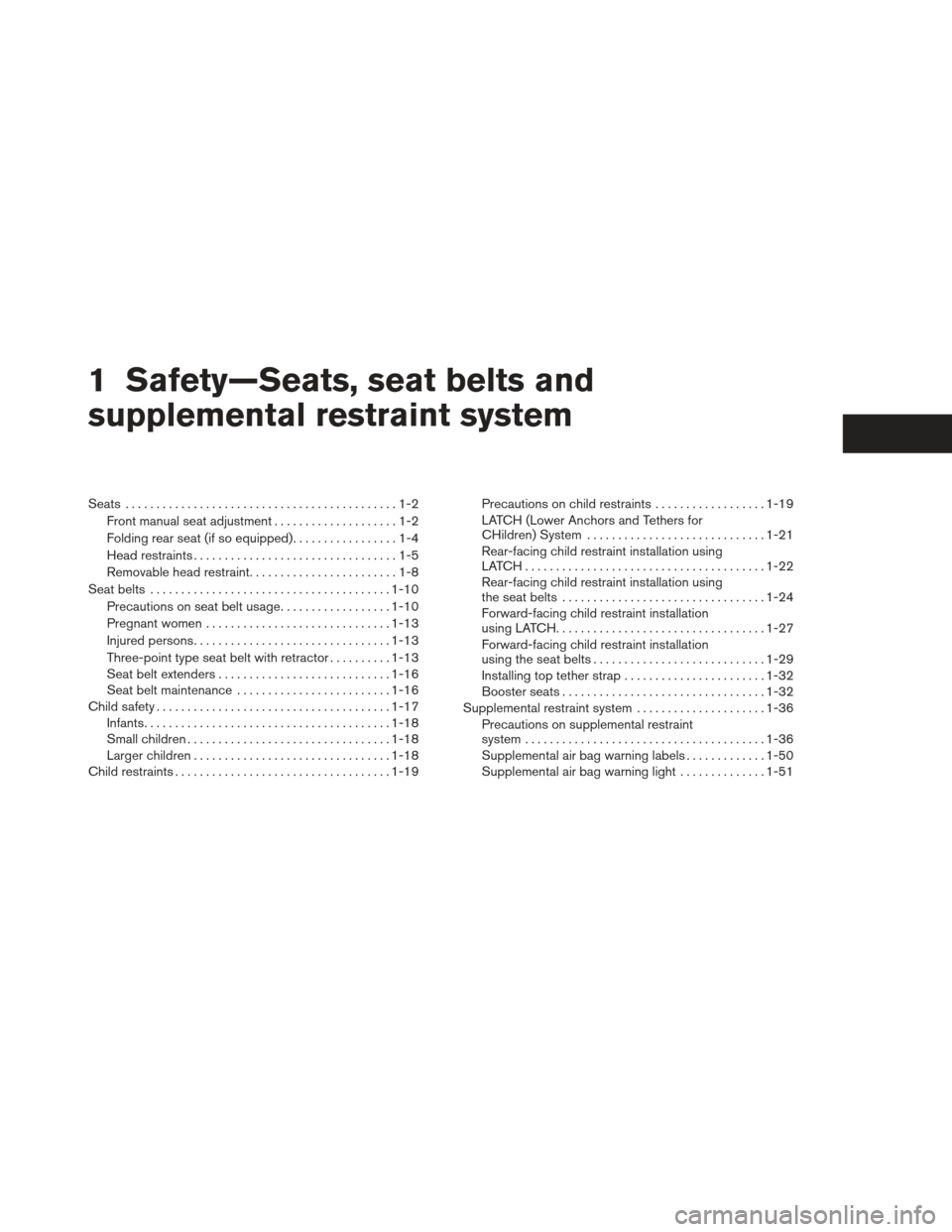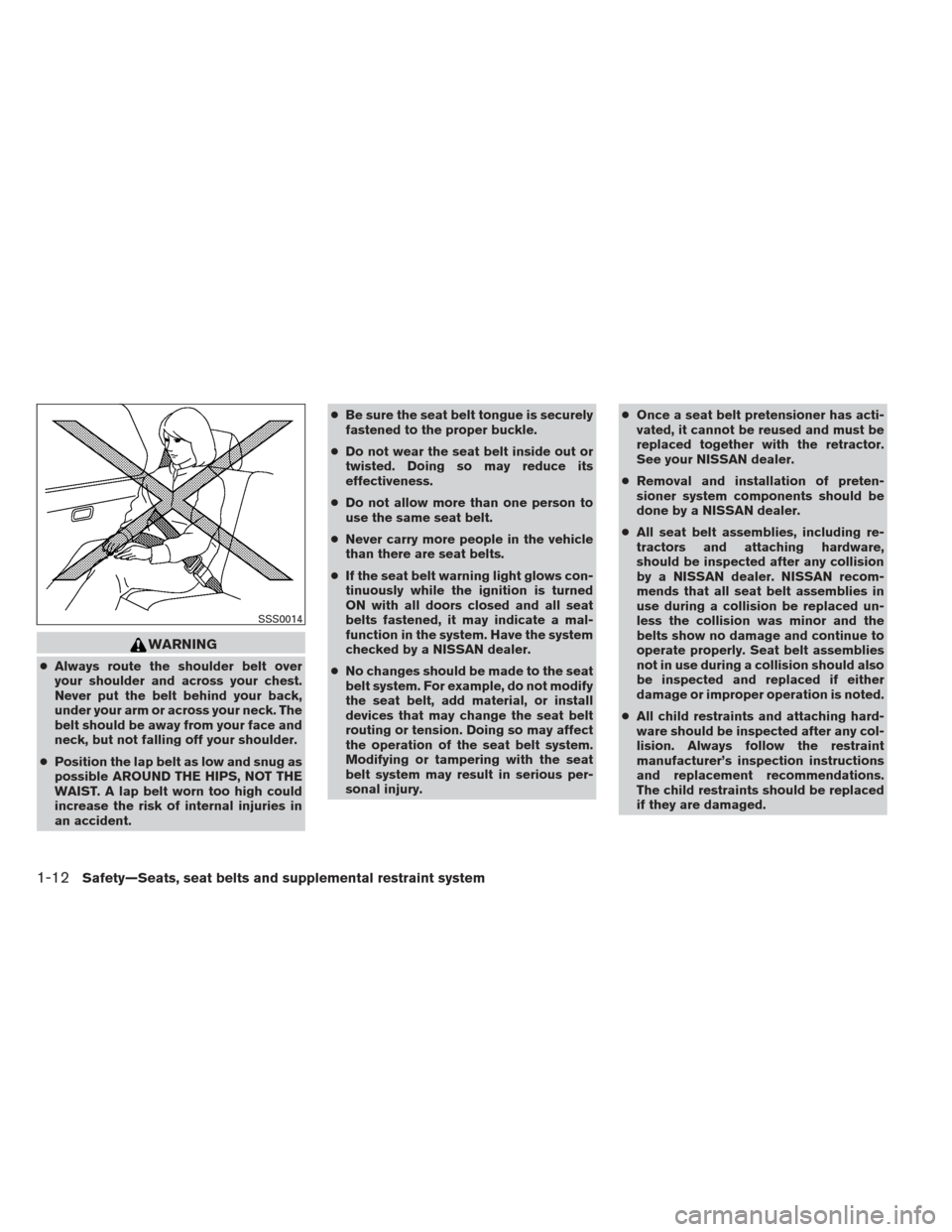Page 8 of 331
0 Illustrated table of contents
Air bags, seat belts and child restraints..............0-2
Exterior front ......................................0-3
Exterior rear .......................................0-4
Passenger compartment ...........................0-5 Instrument panel
...................................0-6
Engine compartment check locations ................0-7
Warning/indicator lights ............................0-8
Page 10 of 331
1. Engine hood (P. 3-24)
2. Windshield (P. 8-18)
3. Windshield wiper and washer switch(P. 2-21)
4. Power windows (if so equipped)
(P. 2-29)
5. Door locks, keyfob, (if so equipped) ,
keys (P. 3-5, 3-2, 3-2)
6. Mirrors (P. 3-31)
7. Tire pressure (P. 8-32)
8. Flat tire (P. 6-3)
9. Tire chains (P. 8-39)
10. Headlight and turn signal switch
(P. 2-22)
11. Replacing bulbs (P. 8-26)
See the page number indicated in paren-
theses for operating details.
LII2016
EXTERIOR FRONT
Illustrated table of contents0-3
Page 12 of 331
1. Rear seat (P. 1-4)
2. Interior lights (P. 2-31)
3. Front seat (P. 1-2)
4. Sun visors (P. 3-30)
5. Interior lights (P. 2-31)
6. Storage (P. 2-27)
7. Glove box (P. 2-29)
8. Parking brake, parking on hills (P. 5-19,5-24)
9. Rear armrest (if so equipped) (P. 1-5)
See the page number indicated in paren-
theses for operating details.
LII2036
PASSENGER COMPARTMENT
Illustrated table of contents0-5
Page 13 of 331

1. Headlight/turn signal switch (P. 2-22)
2. Driver’s supplemental air bag /horn(P. 1-36, 2-25)
3. Meters and gauges (P. 2-3)
4. Windshield wiper/washer switch
(P. 2-21) 5. Center vents (P. 4-13)
6. Rear window and outside mirror (if so
equipped) defroster switch (P. 2-22)
7. Hazard warning flasher switch (P. 6-2)
8. Climate controls (P. 4-14)
9. Audio system (P. 4-31, 4-34, 4-38) 10. Passenger’s supplemental air bag
(P. 1-36)
11. Side vents (P. 4-13)
12. Electronic outside rearview mirror
control switch (P.3-32)
13. Vehicle Dynamic Control (VDC) off
switch (P. 2-25)
14. Fuel-filler lid release lever (P. 3-27)
15. Hood release lever (P. 3-24)
16. Audio control switches (if so equipped)
(P.4-52)
17. Tilt steering (P. 3-30)
18. Ignition switch/Push button ignition
switch (if so equipped) (P. 5-7,
P. 5-9)
19. Cruise control (if so equipped) (P.5-20)
20. Cup holders (P. 2-28)
21. Shift selector (P. 5-15)
22. Glove box (P. 2-26)
See the page number indicated in paren-
theses for operating details.LIC2170
INSTRUMENT PANEL
0-6Illustrated table of contents
Page 15 of 331

Warninglight Name Page
or
Anti-lock Braking
System (ABS) warn-
ing light 2-12
or
Brake warning light 2-12
Charge warning light 2-13
Door open warning
light
2-13
Engine oil pressure
warning light2-13
High temperature
warning light (red)2-14
Warning
light Name Page
or
Low fuel warning
light 2-14
Low tire pressure
warning light (if so
equipped)2-14
NISSAN Intelligent
Key® warning light
(if so equipped)2-15
Power steering
warning light
2-13
Seat belt warning
light and chime2-16
Shift P warning light
(if so equipped)2-16
Supplemental air
bag warning light2-16
Indicator
light Name Page
Automatic Transmis-
sion (A/T)/
Continuously Vari-
able Transmission
(CVT) position indi-
cator light (if so
equipped) 2-16
Cruise main switch
indicator light (if so
equipped)
2-16
Cruise set switch
indicator light (if so
equipped)2-17
Engine start opera-
tion indicator (if so
equipped)2-17
Front passenger air
bag status light
2-17
High beam indicator
light (blue)2-17
WARNING/INDICATOR LIGHTS
0-8Illustrated table of contents
Page 16 of 331
Indicatorlight Name Page
Malfunction Indica-
tor Light (MIL) 2-17
Overdrive off indica-
tor light (if so
equipped)2-18
Security indicator
light (if so equipped)
2-18
Side and headlight
indicator light
(green) (if so
equipped)2-18
Slip indicator light 2-18
Turn signal/hazard
indicator lights
2-18
Vehicle Dynamic
Control (VDC) off
indicator light2-18
Illustrated table of contents0-9
Page 18 of 331

1 Safety—Seats, seat belts and
supplemental restraint system
Seats ............................................1-2
Front manual seat adjustment ....................1-2
Folding rear seat (if so equipped) .................1-4
Head restraints .................................1-5
Removable head restraint ........................1-8
Seat belts ....................................... 1-10
Precautions on seat belt usage ..................1-10
Pregnant women .............................. 1-13
Injured persons ................................ 1-13
Three-point type seat belt with retractor ..........1-13
Seat belt extenders ............................ 1-16
Seat belt maintenance ......................... 1-16
Child safety ...................................... 1-17
Infants ........................................ 1-18
Small children ................................. 1-18
Larger children ................................ 1-18
Child restraints ................................... 1-19Precautions on child restraints
..................1-19
LATCH (Lower Anchors and Tethers for
CHildren) System ............................. 1-21
Rear-facing child restraint installation using
LATCH....................................... 1-22
Rear-facing child restraint installation using
the seat belts . . ............................... 1-24
Forward-facing child restraint installation
using LATCH. . . ............................... 1-27
Forward-facing child restraint installation
using the seat belts ............................ 1-29
Installing top tether strap .......................1-32
Booster seats ................................. 1-32
Supplemental restraint system .....................1-36
Precautions on supplemental restraint
system ....................................... 1-36
Supplemental air bag warning labels .............1-50
Supplemental air bag warning light ..............1-51
Page 29 of 331

WARNING
●Always route the shoulder belt over
your shoulder and across your chest.
Never put the belt behind your back,
under your arm or across your neck. The
belt should be away from your face and
neck, but not falling off your shoulder.
● Position the lap belt as low and snug as
possible AROUND THE HIPS, NOT THE
WAIST. A lap belt worn too high could
increase the risk of internal injuries in
an accident. ●
Be sure the seat belt tongue is securely
fastened to the proper buckle.
● Do not wear the seat belt inside out or
twisted. Doing so may reduce its
effectiveness.
● Do not allow more than one person to
use the same seat belt.
● Never carry more people in the vehicle
than there are seat belts.
● If the seat belt warning light glows con-
tinuously while the ignition is turned
ON with all doors closed and all seat
belts fastened, it may indicate a mal-
function in the system. Have the system
checked by a NISSAN dealer.
● No changes should be made to the seat
belt system. For example, do not modify
the seat belt, add material, or install
devices that may change the seat belt
routing or tension. Doing so may affect
the operation of the seat belt system.
Modifying or tampering with the seat
belt system may result in serious per-
sonal injury. ●
Once a seat belt pretensioner has acti-
vated, it cannot be reused and must be
replaced together with the retractor.
See your NISSAN dealer.
● Removal and installation of preten-
sioner system components should be
done by a NISSAN dealer.
● All seat belt assemblies, including re-
tractors and attaching hardware,
should be inspected after any collision
by a NISSAN dealer. NISSAN recom-
mends that all seat belt assemblies in
use during a collision be replaced un-
less the collision was minor and the
belts show no damage and continue to
operate properly. Seat belt assemblies
not in use during a collision should also
be inspected and replaced if either
damage or improper operation is noted.
● All child restraints and attaching hard-
ware should be inspected after any col-
lision. Always follow the restraint
manufacturer’s inspection instructions
and replacement recommendations.
The child restraints should be replaced
if they are damaged.
SSS0014
1-12Safety—Seats, seat belts and supplemental restraint system